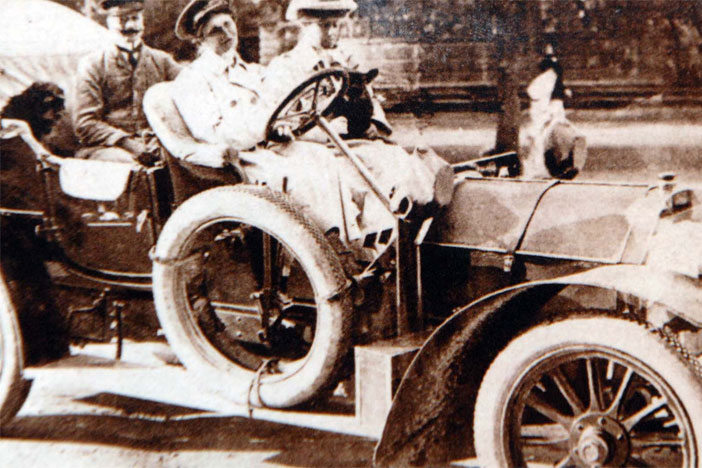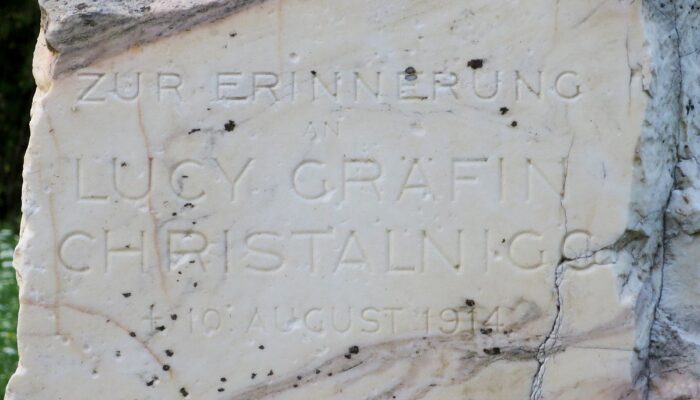
13 Feb Srpenica, Memorial to Lucy Christalnigg
Not far from Srpenica village stands a stone cross, dedicated to the first civilian victim of the World War One in the Soča Valley. Countess Lucy Christalnigg was shot dead on this spot, due to a dreadful mistake.
Along the road that leads from Trnovo ob Soči to the village of Srpenica, you can see a stone cross standing on the right side of the road. It marks the memory of the Countess Lucy Christalnigg, who died here on 10th August, 1914.

COUNTESS LUCY CHRISTALNIGG
Lucy Christalnigg Bellegrade, was a wife of Count Oscar Christalnigg, Slovenian nobleman, colonel in the Austro-Hungarian army and a member of the Knights of Malta. The Count was very popular among Slovenians, because he participated in the establishment of Slovenian primary schools.
Countess Lucy has showed a passion for riding fast horses since young age. After the wedding, the couple had a daughter Maria Immaculata. Barely four-year old girl fell and injured her knee. Wound later got infected and the little girl died. Deeply hurt Countess never fully recovered from this event. Her restlessness has found solace in driving a car.
Countess Lucy was one of the first female drivers in Carinthia. As soon as the very first cars appeared on a market she stubbornly wanted one. Lucy has found a strange peace in the speed and control over the vehicle. Driving a car has now become her passion.
But for Lucy driving a car was not enough, she began to attend car races. And, she won quite few. Everyone, including the anxious husband, were convincing her that she should not drive that fast. They all warned her that she will die behind the wheel.

LAST SUMMER
When on the 28th of July 1914 Austria-Hungary declared war on Serbia the public opinion on the necessity of the war was divided. But everyone agreed that a short war in Serbia would solve many problems of the monarchy. For people in this part of Europe it will mean no harm because they were too far away from the battles.
Despite the distance of the Soča valley from the battlefields in these first days of the war, the Austrians set the guards on the border with Italy. Gendarmes were former soldiers, too old to serve in the front. People’s imagination was full of stories of smugglers, spies and deserters. There have also been rumors that the wealthier people were smuggling their gold to neutral Italy.
Then, the headquarters in Vienna received an information that France intends to send a large amount of gold to Serbia thru the Austro-Hungarian territory. Given that the countries fought on opposite sides such an act was considered outrageous. Therefore, the commands were clear and applicable to all – stop at the first stop sign ALT.
Lucy has been a great supporter of the Red Cross even before the declaration of war. But she was not satisfied with just fund-raising like other noble ladies. She had to be actively involved in the operations of the Red Cross.
Thus, on 9th of August in the evening she picked up an ambulance in Klagenfurt. The vehicle was full of drugs and other medical equipment and was to be donated to the Red Cross in Gorizia. Count Oskar handled an official pass before her departure, for the gendarmes along the road to let her pass. All patrols were also informed of her journey.
TRAGIC JOURNEY
So the elegant lady found herself alone behind the wheel on a dark night and during the war. Around midnight Lucy passed Predel, and then descended to the valley.
Before the village of Srpenica, the road was guarded by a local Peter Fon that night. When he saw the car, he shouted and gave a sign with his hands and a flashlight. But Countess did not stop. Fon raised his gun and fired as he was ordered.
The car stopped, but it was too late. Lucy was shot in the head and the countess died on the spot. Nobody knows why she did not stop. Perhaps she overlooked the patrol in the darkness or has she relied on the fact that the guards are informed of her journey. The bold Countess really died behind the wheel, as she was warned. Only not in a car accident.
NIGHT OF THE SHOOTING STARS
When officers in Gorizia learned about the tragedy, the gendarmerie was ordered not to touch anything until the arrival of the Military Commission. Thus, the body of the Countess remained in the car all day. At seven in the evening they finally arrived. The Countess was taken to Gorizia by a funeral car on 10th August, the night of the shooting stars.
Count Oskar silently listened to soldiers who described event. He knew that the gendarmes acted in accordance to orders. Count eventually rewarded the soldiers on patrol with five crowns because they did their duty. Then, in memory of his wife he placed this stone cross in Srpenica, just a few months before the outbreak of the Isonzo front. And, here it still stands today.
Distant war has suddenly become a lot closer. Now they all knew its first victim. And, a few months later, when the Kingdom of Italy declared war on Austria-Hungary, the trenches outgrown this idyllic land by the Soča River.
